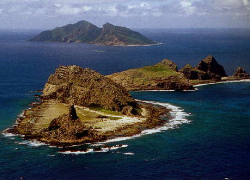On Monday, November 26, the United States sent two B-52 bombers over a group of disputed islands in the East China Sea after China recently declared that the islands were within the country’s air defense zone. The disputed islands, called the Diaoyu Islands by the Chinese, and the Senkaku Islands by the Japanese, are at the heart of an international dispute in which each country claims the islands as their own.

The islands are prized for their strategically significant location to nearby shipping lanes, and for their potential abundance of natural resources. Modern dispute over the ownership of the islands has existed since the 1970s. However, the dispute over the islands seems to be escalating. A little over a year ago Japan sent fighter jets to the islands after a Chinese plane was sighted in the area on December 13, 2012. That marked the first time that aircraft became involved in the dispute.
A little less than a year later, on November 23, 2013, China released information pertaining to the coordinates of its new air defense zone, which happens to encompass the Diaoyu/Senkaku islands. It accompanied the release with a declaration requiring any aircraft entering the zone to clearly mark the nationality of the aircraft and for pilots of the aircraft to identify themselves and to report their flight plans to Chinese authorities. Additionally, China claimed that it would defensively respond to aircraft that refused to follow these procedures.
Three days later, the United States flew two unarmed B-52 bombers over the islands, which lie within the new Chinese air defense zone. The United States claimed that the flyover was part of a training exercise. The United States conducted the exercise following its normal procedures, which disregard China’s new requirements for aircraft entering the zone. China has not directly responded to the actions of the U.S., but claims that the new air defense zone is a proper exercise of its right to self-defense and territorially integrity.
The institution of the Chinese air defense zone and the United State’s flyover of the Diaoyu/Senkaku islands demonstrate that tensions over the disputed islands are escalating. These events come on the heels of a recently released statement by the United States about its focus on enhancing security in the Asia-Pacific region through increasing the presence of U.S. forces. With a larger U.S. presence in the region, and with an already strained relationship between China and Japan, a diplomatic resolution is needed sooner rather than later. In fact, a peaceful resolution to the Diaoyu/Senkaku dispute could help build a bridge to better relations between all parties involved.
Lincoln Puffer is a 3L and is the Cite and Source Editor of the Denver Journal of International Law and Policy

